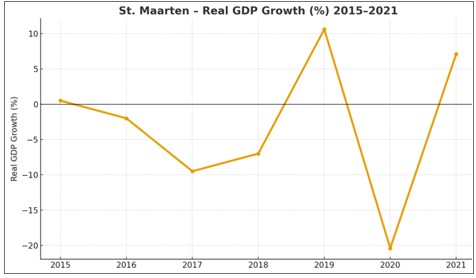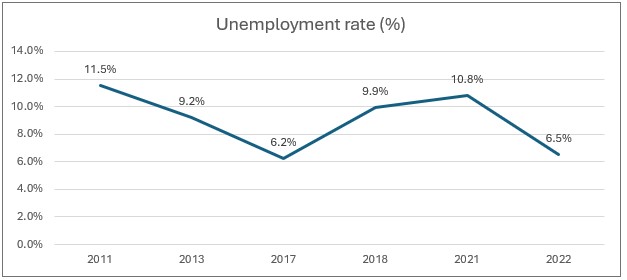World Statistics Day 2025 – “Connecting the World with Data We Can Trust”
Since October 10, 2010, when Sint Maarten adopted its new constitutional status and embarked on its path as a country within the Kingdom of the Netherlands, one guiding force has remained constant - data. Behind every policy, national plan, and measure of progress lies a story told through numbers. On this World Statistics Day 2025, celebrated under the theme “Connecting the World with Data We Can Trust,” the Department of Statistics (STAT) highlights key developments in population, economy, tourism, and employment, offering a data-driven view of Sint Maarten’s growth and resilience over the past fifteen years.
Economy and Tourism: From Shocks to Recovery
In the years leading up to 2017, Sint Maarten saw solid expansion in both air and cruise arrivals. Rising airlift capacity, new accommodation options, and regional demand fueled income growth, employment, and GDP growth.
Passenger Arrivals, 2010–2025 (Selected Years)
|
Year |
Air Arrivals |
Cruise Arrivals |
Notable Events |
|
2010 |
443,000 |
1.6 million |
Attained country status |
|
2016 |
528,000 |
1.8 million |
Peak pre-Irma tourism |
|
2017 |
446,000 |
1.2 million |
Hurricane Irma's impact |
|
2020 |
106,000 |
436,000 |
COVID-19 pandemic |
|
2023 |
395,000 |
1.3 million |
Strong recovery phase |
|
2025 (Jan–Jul) |
538,000 |
987,000 |
Surpasses pre-pandemic levels |
|
(Source: Department of Statistics, 2025) |
|||
While tourism continues to drive growth, it also exposes the economy to external shocks. The impact of Hurricane Irma (2017) inflicted large-scale damage, leading to contractions of around –9% in 2017 and –7% in 2018.
 The Gross Domestic Product (GDP) showed a strong rebound of +10.6% in 2019 as reconstruction accelerated. The COVID-19 pandemic then struck in 2020, causing a severe –20.4% contraction as global travel came to a standstill. By 2021, GDP recovered by +7.1% showing the island’s remarkable capacity for renewal.
The Gross Domestic Product (GDP) showed a strong rebound of +10.6% in 2019 as reconstruction accelerated. The COVID-19 pandemic then struck in 2020, causing a severe –20.4% contraction as global travel came to a standstill. By 2021, GDP recovered by +7.1% showing the island’s remarkable capacity for renewal.
These fluctuations highlight both Sint Maarten’s economic vulnerability and its capacity for recovery, underscoring the importance of diversity and sustainability in long-term development planning.
Inflation Developments
Over the past fifteen years, inflation in Sint Maarten has remained relatively low and stable, averaging between 1% and 3%. However, 2022 marked the highest level in the period, a little less than 4%, reflecting global supply disruptions and rising import costs.
According to the Consumer Price Index (CPI) report for 2025, overall inflation for the first half of the year remains subdued at 0.7% compared to the same period of 2024. The most notable increases occurred in:
- Food and Non-Alcoholic Beverages (+4.03%), mainly from higher prices for milk, cheese, eggs, oils, and fats;
- Transport (+2.99%), due to rising fuel and air travel costs;
- Miscellaneous Goods and Services (+2.54%), driven by personal care and insurance expenses.
These movements reflect the impact of imported inflation, particularly in food and fuel, consistent with regional and global price trends. The current moderation indicates that inflationary pressures are easing, offering some relief to consumers and businesses alike.
Caution due to uncertain and ongoing tariff and trade wars may cause inflation in the short term.
Employment: Developments in Labor Market
Labour market performance has generally improved over time, with fluctuations linked to natural disasters and global crises. Unemployment fell from 11.5% in 2011 to 6.2% in 2017, the lowest level in fifteen years, before rising to 9.9% in 2018 following Hurricane Irma. Due to COVID-19, Unemployment once again increased in 2021 to 10.8% but has since reduced to 6.5% in 2022.

Recent data gathered from the 2022 Population Census show Youth Unemployment (ages 15–24) at approximately 15%, slightly below the Caribbean average of 18% and close to the global average of 13%. This improvement is encouraging but highlights the ongoing need to create more opportunities for young people through education, training, and targeted job-placement initiatives.
The upcoming 2025 Labour Force Survey will provide updated figures to help policymakers better understand the island’s employment landscape and guide future interventions.
Population: Growth and Demographic Change
Sint Maarten’s population has grown steadily over the past fifteen years. The 2011 census recorded 33,609 residents, while by 2022 that number had reached 41,902, an increase of roughly 25%. This consistent growth has made Sint Maarten one of the most densely populated and urbanized islands in the Dutch Caribbean.
Demographically, the island has undergone a marked shift toward an older population. In 2011, only 5.3% of residents were aged 65 and over; by 2022, that share had more than doubled to 13.6%. Meanwhile, the proportion of children under 15 declined from 22.1% in 2011 to 15.5% in 2022. This trend mirrors global aging patterns, but for a small island economy, it carries major implications, from a shrinking labor force to higher healthcare demand and greater pension pressures.
Conclusion
Fifteen years of data reveal a country that has faced significant adversity — from hurricanes to a pandemic — yet continues to demonstrate strength, adaptability, and growth.
- Population growth and urbanization have expanded demand for jobs, housing, and infrastructure.
- Tourism recovery and stable inflation point to economic resilience and improving consumer conditions.
- Declining unemployment and lower youth joblessness signal gradual labour-market progress, even as challenges persist.
- An aging population and dependence on tourism remain key areas for forward-thinking policy and planning, especially in areas of healthcare and pension demands.
To sustain progress, Sint Maarten must diversify its economy, expand training and employment pathways, and strengthen data-driven policymaking. By investing in people, innovation, and resilience, the island can build a more inclusive and sustainable future.
Looking Ahead: Building on Trusted Data
As Sint Maarten reflects on fifteen years of progress, one message stands clear: data is the foundation of development.
The Department of Statistics (STAT) remains committed to providing reliable and timely information that strengthens decision-making, enhances transparency, and supports inclusive growth.
Over the coming months, STAT field interviewers will be in communities across Sint Maarten conducting the 2025 Labour Force Survey. Your participation is vital. By sharing accurate information, you help build a clearer picture of our society and contribute directly to improving public policy and service delivery.
On World Statistics Day 2025, Sint Maarten proudly joins the global community in celebrating the power of trusted data to connect people, inform progress, and build a resilient future.
For more information, visit https://stats.sintmaartengov.org/.